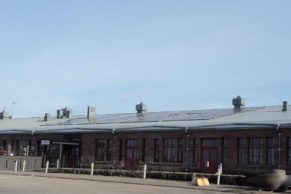Environment
SUSTAINABLE PORT OPERATION
The Port of Hanko is one of the most important logistical centres of international sea transports in Finland. Hanko is located in the southern-most tip of Finland where the Baltic Sea meets the Gulf of Finland and the Finnish archipelago. The port is partly located in the middle of the city, in a protected cultural environment, which poses high demands for the operation. The port is located in a unique environment surrounded by the sea, where the environment is defined by several groundwater and conservation areas as well as areas belonging to the Natura 2000 network.
The most important environmental demand set for the port is caring for the sensitive environment surrounding it.
Port of Hanko Ltd has created an environmental policy with requirements and goals for its operation.
Port of Hanko environmental policy 28.4.2020 (in Finnish).
In the year 2020, Port of Hanko Ltd was granted the Finnish Hyvä YVA -award for best environmental impact assessment work. This means that the port is a forerunner in many ways when it comes to environmental work in ports.
AN ENVIRONMENTAL PERMIT IS REQUIRED
In Finland, port operations require an environmental permit in accordance with the Environmental Protection Act’s §1, section 28. The port operations of Port of Hanko Ltd were granted an open-ended environmental permit for the Western Harbour in 2003, the Outer Harbour in 2012 and for the Koverhar Harbour in 2015. The environmental permit sets conditions for operations, which can affect e.g. comfortability (noise), water and air quality, soil and groundwater. Port of Hanko Ltd endeavours, in all of its operations, to ensure that both its own operation and the operation of the other companies located in the port area burden the environment and its inhabitants as little as possible.
All the vessels visiting the port and the companies operating in it must follow the requirements of the valid environmental permit that defines the operation of the port in Hanko. Monitoring officials regularly check that these conditions are met.
More information on environmental permits

Environmental permit for Western Harbour operations
Jnl No. LSY-2003-4-483
Environmental permit for Outer Harbour operations
Jnl No. ESAVI/295/04.08/2012
Environmental permit for Koverhar Harbour operations
ESAVI 123/2021 nro: ESAVI/4582/2020
VHO 290/2023 nro: 20733/03.04.04.04.19/2021
KHO 1868/2024 nro: 087/03.04.04.04.19/2023
MANAGING ENVIRONMENTAL EFFECTS
Noise emissions
Noise in ports is caused by vessels, work machines and general traffic in the area. The port’s noise levels are monitored with noise assessments, which observe the ports noise emissions during various situations and the resulting values are compared to the values defined in the environmental permits of the ports. The Port of Hanko has new noise assessments and noise predictions done regularly, or when parameters change, in accordance with the conditions of the environmental permit.
In everyday cooperation with the companies operating in the area, e.g. the machine stock is continuously improved. Additionally, more efficient, safer and less noise-producing procedures are continuously developed. The port takes all noise very seriously. Port of Hanko Ltd is also e.g. one of the first ports in Finland to measure the underwater noise it causes.
Emissions into air
The main producer of air emissions is ship traffic. The sulphur emissions produced by ship traffic have significantly reduced since the sulphur directive became effective in the Baltic Sea special area in 2010. The directive was tightened in 2015 and the ship sulphur emissions were restricted to 0.1% in the entire Baltic sea. The Port of Hanko is also visited by vessels using alternative fuels, such as LNG vessels.
Emissions into the sea
The effects the Western Harbour and the Outer Harbour of Hanko have on the surrounding sea area have been monitored for years. There are long observation point time data series on the effects of both the harbours. Based on this knowledge, the port has had very little effect on the surrounding sea area.
Development initiatives and investments in the sea areas always require water permits, which define the conditions for building and the environmental impacts.
The Port of Hanko is also carefully prepared in case of accidents in which dangerous substances may leak into the sea. The preparedness is continuous, 24 hours a day, every day of the year.
Ship waste
According to the ship waste legislation, ships must leave their waste in the port. A large part of the traffic coming into the Port of Hanko is regular route traffic and the shipping companies can organise their waste management themselves. For others, the Port of Hanko organises modern waste handling in their facilities.
TARGET STATE
A carbon neutral port
In the coming years, cutting the carbon dioxide emissions in the port area is one of the port’s main targets. Together with the shipping companies and the other operators of the area, the goal is to raise energy efficiency and increase the use of renewable forms of energy. To reach these goals, the parties have drawn up plans of action both together and individually. The goal, which Port of Hanko Ltd has set for itself, is to be the first 100% carbon neutral port in Finland by the year 2024.

162 solar panels on the roof of the Voimakasiini building